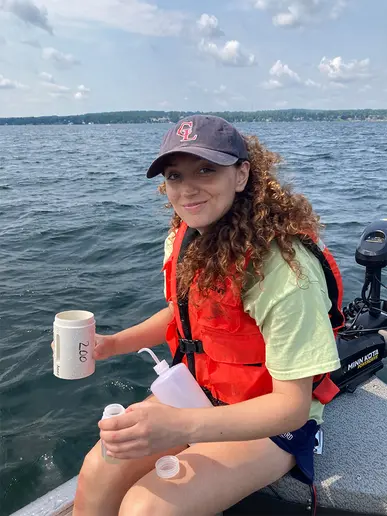

Sydney Hawkins, collecting new samples in Chautauqua Lake.


Sydney Hawkins, collecting new samples in Chautauqua Lake.
A junior Biology major, through a summer internship, is getting a “good look into the research world” through career-building skills.
Sydney Hawkins, of Ripley, NY, is focusing on the study of harmful algal blooms (HABs) in Chautauqua Lake. Her research experience, “Identifying the Species Composition of Benthic Algae in Chautauqua Lake,” is through the Rensselaer Polytechnic Institute (RPI) and the Jefferson Project, a multi-year research program examining water quality and harmful algal bloom in that lake and other bodies of fresh water. Both are funding the internship.
“The overall goal of the Jefferson Project is to work to understand HABs in order to improve their management in lakes. The research I’m involved with is one piece within that puzzle,” Ms. Hawkins explained. “Specifically, I’ve been working with samples of Gloeotrichia that were collected last summer. Gloeotrichia is a type of cyanobacteria that is native to Chautauqua Lake, but can contribute to HABs during periods of overgrowth.”
This research experience has given Sydney a good look into the research world and will hopefully give her many skills that will be useful in a research career, including technical, experimental design and communication skills” – Dr. Allison Hrycik
Hawkins is compiling microscopic counts throughout the summer, according to Visiting Assistant Professor Allison Hrycik, who works for RPI and the Jefferson project. Hawkins will also collect a variety of samples at various locations around the lake this summer that will each be processed for a different purpose, such as water chemistry or taxonomic work.
Routine monitoring around the lake and other smaller experiments that seek answers to specific questions are also on Hawkins’ agenda.
Since this is her second summer in this internship, Hawkins is already familiar with most of the field equipment that’s being used, such as a Secchi disk and a Van Dorn, or integrated sampling tube. More recently, she’s gained experience with software, such RStudio, ImageJ and Leica microscope software.
A typical work schedule involves biweekly sampling at the lake and sample processing and other tasks performed in a campus lab.
“This research experience has given Sydney a good look into the research world and will hopefully give her many skills that will be useful in a research career, including technical, experimental design and communication skills,” said Dr. Hrycik, who is Hawkins’ faculty adviser and has been studying HABs since 2016. Hawkins has also met and collaborated with several other researchers, mostly from RPI and IBM Research, on field work.
“HABs are a worldwide issue, and not an easy problem to solve,” acknowledged Department of Biology Associate Professor Courtney Wigdahl-Perry, “so our best strategy is to approach it from as many angles as possible, and part of our role here is to feed into that bigger picture perspective, so we’re working on learning not just about Chautauqua Lake and HABs here, but also comparing that to other sites around the world.”
Chautauqua Lake represents Project Jefferson’s biggest investment in research time outside of Lake George, its home base.
Robust is how Dr. Wigdahl-Perry describes HAB research at SUNY Fredonia. “We’ve looked at a lot of different aspects of lake ecology, understanding and looking into not just HABs, but [also] lake ecology that supports all those things living there, for better or worse.” She has studied HABs at Chautauqua Lake since 2014, when she joined the SUNY Fredonia biology faculty.
Hawkins, who has a minor in Chemistry and is a member of the Fredonia Biology and Chemistry clubs and the North American Lake Management Society, plans to present her research at the university’s 2025 OSCAR Expo and deliver an oral presentation within the Department of Biology. She is a graduate of Chautauqua Lake Central School.
This research experience is highly valuable to Hawkins, connecting well with her plans to earn a master’s and Ph.D. degrees in research settings.
“Ultimately, I would like to be a research scientist focused on areas related to molecular ecology. Specifically, I would like to tackle environmental and/or organismal questions with both an ecological perspective and a proficiency in molecular techniques,” Hawkins said.
There’s no substitute for hands-on experience when it comes to learning about work in the field and science lab, according to Wigdahl-Perry.
“Not only does she get to work with faculty here, she’s also connected to the Jefferson Project, which has an array of different types of experts, different tools and different questions that they’re trying to answer,” she added.
“Sydney is building a skill set and also network connections,” Wigdahl-Perry said.